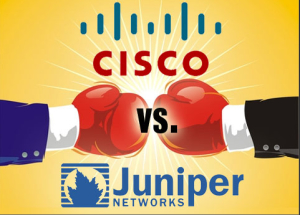Juniper vs Cisco

The physical design of Cisco has some differences from the Juniper’s. We will try to show the most important.
To start Cisco has a very hierarchical structure; Core / Distribution / Access even though the Nexus family can unify the distribution layer and access through the Nexus 5000. They act as a chassis for the Nexus 2000 which are the access switches. That's where these are connected to end devices such as servers and storage equipment, similar to what happens with the Juniper equipment.
One of the most notable differences of Cisco is that in order to avoid the problems of level 2 loops, a specific technology has been created, the Spanning Tree. In this case is not full mesh architecture so it requires a protocol that enables these loops break. The protocol created was vPC (Virtual Port Channel). This technique sees switches of superior level as a single virtual switch thus avoiding loops. This will allow all the ports to be active and substantially increase bandwidth available.
Another difference is that Cisco has UCS (Unified Computing System). Its purpose is to unify network resources, management, virtualization and storage access into a single integrated architecture. This unique architecture allows having generic visibility of servers for the management and control of both physical and virtual environments.
Another protocol created exclusively for Cisco equipment is the CEF (Cisco Express Forwarding). Its’ a protocol used to perform load balancing increasing the speed of packet switching by reducing overhead and delay.
Sometimes numbers give us a good idea what are we talking about. So here is an example of "How much will an enterprise have to pay for your core switch with the components to support 96 10 Gigabit Ethernet (10 GbE) ports in a chassis?"
Cisco: Approximately $240,000 U.S. list. This includes a 6509-E switch chassis, Sup2T 9 Slots Bundle ($38,000), Six 6816 Line Cards ($32,000) and dual power supplies ($5,000). The expected lifespan of this product is 10 to 15 years. 2 Tbps of bandwidth
Juniper: Approximately $145,000 U.S. list. This includes the EX8216 redundant chassis with 96 line-rate 10 GbE ports. As a 5:1 oversubscribed 10 Gigabit Ethernet switch, the average selling price would be approximately $75,000. 5.1 Tbps of bandwidth
Who will win the final battle?
